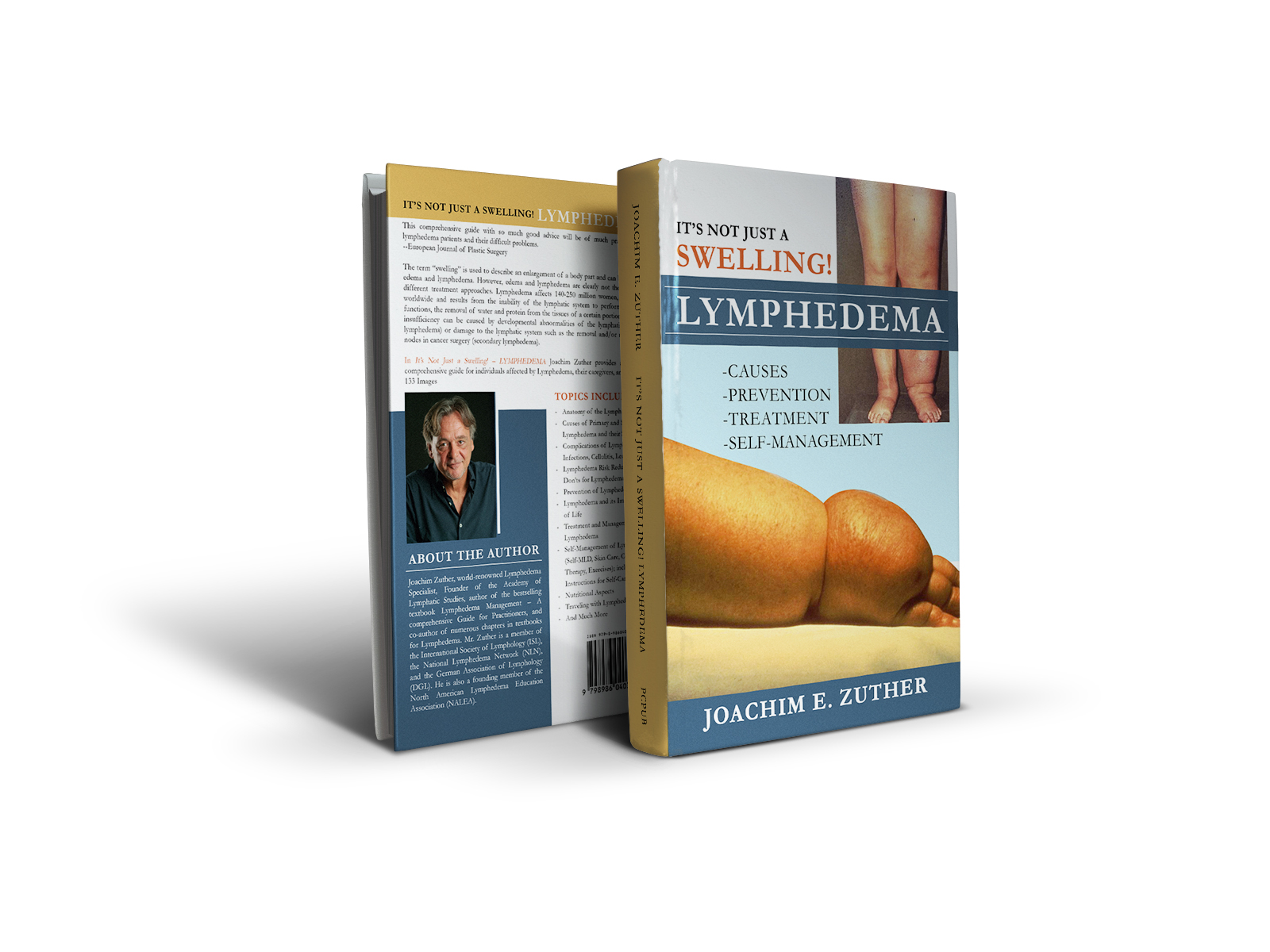New Book for Patients and Caregivers 
In It’s Not Just a Swelling! – LYMPHEDEMA Joachim Zuther provides an up-to-date and comprehensive guide for specifically geared towards individuals affected by Lymphedema, their caregivers, and family members. 133 Images. Paperback and Kindle version
Topics include:
- Self-Management of Lymphedema (Self-MLD, Skin Care, Compression Therapy, Exercises); includes Instructions for Self-Care with images
- Nutritional Aspects
- Lymphedema Risk Reduction, Do’s and Don’ts for Lymphedema
- Complications of Lymphedema, such as Infections, Cellulitis, Leakage
- Lymphedema and its Impact on Quality of Life
- Traveling with Lymphedema
- Prevention of Lymphedema
- Treatment and Management of Lymphedema
- Causes of Primary and Secondary Lymphedema and their Stages
- Anatomy of the Lymphatic System
- And Much More
Click Here to Buy
The Author 
Joachim Zuther, Lymphedema Specialist. Read more |
By Joachim Zuther, on July 1st, 2022
Dear Friends in the Lymphedema Community!
I am very happy to report that the new book “It’s Not Just a Swelling! Lymphedema” is a big success; many of you who already read and use it have reported back to me indicating that the contents are very useful and a great help in dealing . . . → Read More: New Lymphedema Book for Patients
By Joachim Zuther, on April 7th, 2024
In metastasis, cancer cells break away from where they first formed (primary cancer), travel through the blood or lymph system and form new tumors, known as metastatic tumors in other parts of the body. The metastatic tumor is the same type of cancer as the primary tumor.
The lymphatic system consists of the . . . → Read More: Lymph Nodes and Metastases
By Joachim Zuther, on February 24th, 2024
A number of patients who underwent axillary lymph node dissection (ALND) in combination with breast cancer surgery experience postoperative pain and limited range of motion associated with a palpable cord of tissue extending from the axilla into the arm on the same side. This condition is known as Axillary Web Syndrome (AWS), or . . . → Read More: Lymphedema Cording (Axillary Web Syndrome)
By Joachim Zuther, on February 4th, 2024
Unlike the heart in the blood circulatory system, the lymphatic system does not have an active pump to propel lymphatic fluid back to the bloodstream. Effective lymph flow depends on sufficient muscle and joint activity, especially if the functionality of the lymphatic system is compromised. Decongestive exercises are most effective if performed while . . . → Read More: Decongestive and Breathing Exercises for Lymphedema
By Joachim Zuther, on January 1st, 2024
The surgical procedures performed on individuals affected by breast cancer may be mastectomy, partial mastectomy, or lumpectomy. Along with the actual breast surgery for cancer, axillary lymph nodes are removed and/or radiated. As a result of axillary lymph node clearance, the normal lymphatic drainage from the extremity is impaired, and some patients experience the onset . . . → Read More: Lymphedema Risk Reduction
By Joachim Zuther, on January 1st, 2024
I would like to thank Dr. Judith Nudelman for writing this article on the importance of practicing appropriate risk reduction for individuals affected by, or at risk of developing lymphedema.
Dr. Nudelman is an Associate Professor of Family Medicine, Clinical at Alpert Medical School, Brown University. She is also a Certified Lymphedema Therapist (CLT), . . . → Read More: Debunking Lymphedema Risk Reduction Behaviors: Not So Fast
By Joachim Zuther, on November 2nd, 2023
The primary role of compression garments in lymphedema management is to maintain the reduction of the swelling achieved during the intensive treatment phase of Complete Decongestive Therapy (CDT). A high level of consistency in providing the appropriate compression is crucial in order to avoid re-accumulation of evacuated lymphedema fluid. This consistency is provided . . . → Read More: How to Care for Your Compression Garments
By Joachim Zuther, on October 18th, 2023
Pitting
Lymphedema is a very common and serious condition, affecting at least 3 million Americans. However, there is no consistency, as well as a lack of literature regarding the data on the general incidence of primary and secondary lymphedema. Incidence rates in the literature vary greatly, which results from the variety . . . → Read More: On the Importance of Lymphedema Screening for Upper and Lower Extremities Following Surgical Procedures
By Joachim Zuther, on September 22nd, 2023
Various surgical procedures for the treatment of lymphedema have been practiced for over a century and advancements in medical technologies have led to increased discussion of the role surgical treatment as an alternative or additional treatment option for a select group of patients affected by lymphedema. Recent research indicates that the surgical approach . . . → Read More: Reconstructive Surgery for the Treatment of Lymphedema?
By Joachim Zuther, on August 15th, 2023
“After a day of sitting in the office my ankles are swollen.”
“During the last several months of my pregnancy, my legs practically doubled in size”
“My fingers and hand frequently get puffy following a long hike”
“My arm started swelling after I had surgery for my breast cancer”
“Following the removal of . . . → Read More: When is it Lymphedema? Self-Check for Lymphedema
By Joachim Zuther, on July 25th, 2023
Complete decongestive therapy (CDT), sometimes referred to as complex decongestive therapy, or combined physical therapy is the internationally recognized “gold standard” treatment system for the vast majority of patients affected by lymphedema.
Backed by long standing experience, CDT has shown to be safe and effective as the standard therapy for lymphedema. It is . . . → Read More: Complete Decongestive Therapy in the Treatment of Lymphedema
|
Support the Lymphedema Blog This blog is supported by donations. Click to donate today.

Disclaimer The information on this web site is not intended to give medical advice and does not necessarily reflect the opinions of any physicians, nor is it guaranteed to be correct and complete. You should not rely on any information in this web site without seeking the advice of a physician or certified healthcare provider.
|


 Joachim Zuther, Lymphedema Specialist.
Joachim Zuther, Lymphedema Specialist. 
